After I got back from L.A., I meant to spend some time testing methods for constructing this Claire McCardell dress, from an early 50s pattern by Spadea:
I intended to sew it up back in August for my sister, who is the Artistic Director of the Martha Graham Dance Company, to wear to an event at the “Dance & Fashion” exhibit, (now running through January 3rd, 2015, at the Museum at FIT in New York). To have a flashback to that whole explanation, click this link. (Cue the Twilight Zone-y flashback music)
I thought Claire McCardell was a good choice for this event, because McCardell and Martha Graham are often mentioned together in books and articles as being similar in their pared-down artistic style. They did meet on at least one occasion, when they both received the Women’s Press Club award in 1950, a very big deal back then.
Here they are with President Truman (looking dapper in a tuxedo), along with a foreign affairs expert, an educational reformer, and a Hollywood actress (Olivia de Havilland), all in old-school tulle-centered eveningwear. Martha Graham is on the far left looking very chic and modern in her spare little black dress. And Claire McCardell, on the far right? Well, she’s got on one of her wrapped-bodice evening dresses of sari silk, slouchy leather gloves, no bra, no girdle, the ballet flats she invented, and a big American grin on her face. That outfit was so far ahead of its time!
I was doing a lot of thinking about making the dress, as August became September, but now it was October, and little voice inside me (either the spirit of Claire McCardell, or more probably, my Bernina, Karl) whispered, “you better get crackin’ on that dress.”
So, I chose a mid-weight black New Zealand merino knit that I got this spring from The Fabric Store in L.A. (here’s that post), because McCardell was one of the first American designers to popularize wool knits, and Martha Graham often used jersey in her costumes. This fabric is very soft and drape-y, and the quality is wonderful. The Fabric Store now has an online gallery, and will do mail order if you call them. (Here’s The Fabric Store’s USA website)
I washed the wool in cold water, tumble-dried it low, and laid it out.
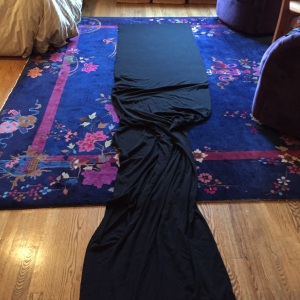
As I was pinning, I was thinking a lot about Martha Graham, and how she often manipulated fabric in her dances to help tell the story.
This long piece of jersey reminded me of a moment in the dance “Cave of the Heart,” which is based on the Greek legend of Medea, and deals with revenge. It’s a favorite dance of mine, particularly now that I’m a “woman of a certain age.” Martha Graham herself designed the costumes, which makes her a “triple threat”: dancer, choreographer, and draper. The dance premiered in 1946.
In the dance, Medea learns that her husband is leaving her for a younger woman, a princess no less, who flits around the stage being innocent and adorable while she’s followed around by the besotted big lug.
Of course Medea, who’s been around the block a few times, is not happy that her husband is having a mid-life crisis, and she gets REALLY mad. Another dancer, representing the “chorus” from classical Greek theater, tries to stop Medea from exacting revenge, to no avail.
In this photo, you can see the Chorus’s robe and skirt, which remind me in particular of a 20s design by Madeleine Vionnet, shown here in the Betty Kirke book “Vionnet”:
In a fit of vengeful rage, Medea gives the little homewrecker a poison crown, which of course the princess puts on right away, because she’s a princess, and it’s a crown! For a couple of minutes she’s skipping around really really happy, and then she grabs her head and eeeeeek!
After that, Medea does an intense solo about vengence, where she’s twisting, twirling and even eating a long “snake” of fabric she pulls out of her bodice, so it’s like she’s “eating her heart out.”
A while later, Medea walks regally across the stage wearing a long train of fabric, and when her macho husband (see below) pulls back the train, the dead princess is inside!
In the end, even though Medea has clearly gone mad, she still looks kind of, well, let’s say satisfied. And that’s what I love about Martha Graham’s dances; they really get to the emotional core of these classic stories. Seeing them is so cathartic!
(Okay, I know I’m in trouble with my sister for being flip about this great Martha Graham work, but Cave of the Heart is prime example of how Graham was inspired by fabric and costumes, and used them to advance the story of her dances.)
Just FYI–the Martha Graham Dance Company New York season will be running February 10-22, 2015, at the Joyce Theater. Tickets can be purchased here: (Link to Martha Graham Company tickets). The Graham photos above are by Christopher Jones, and the dancers are: Medea: PeiJu Chien-Pott, Jason: Ben Schultz, Princess: Xiaochuan Xie and Chorus: Natasha Diamond-Walker.
When it came time to construct the dress, I looked inside an original McCardell that I have in my collection, to see how the seams were finished. I was surprised to see that the finishes were different in different parts of the dress, leading me to believe that several different people worked on the dress using their own methods.
The center back seam allowances were folded under and sewn:
The pockets edges were finished with pinking shears (kind of sloppy, too):
The armscye seams were double-sewn on the inside, but not top-stitched.
Several seams were reinforced with bias tape, which is typical of McCardell dresses, as they are often are cut on the bias and need the tape to stabilize the seam.
Meanwhile, the “let’s get crackin'” concept was still in my head, so my Bernina 560, AKA Karl, whispered, “how about forgetting the seam finishes and using the overlock stitch, sister?” This would have been heresy to me as a vintage purist, except I had recently read this post by The Vintage Traveler talking about how overlock stitches were used on sportswear as early as the 1910s. That was my “Get Out of Jail Free” card!
Using the 2A foot, and the #10 overlock stretch stitch, I got cranking. The foot shoves the edge under the needle, so you don’t need a serger for a finished edge.
Looks great, no? The wool jersey sewed like a dream.
The great thing about these 50s and 60s patterns released by Spadea, is that they were not taken from designs developed for the home sewing market. These patterns were drafted in reverse: a retail garment was given to the patternmaker, who took apart the garment, drafted the pattern from the pieces, graded the pattern for different sizes, then wrote up the instructions for the home-sewer.
So by sewing from a Spadea pattern now, you truly can recreate designer clothing from that era that look just like the retail garments being sold at the time.
Generally instructions in the Spadea patterns are great, but this one was little backwards in some ways.
The beginning of the instructions tell you to construct the back and side seams of the entire dress, so as you’re doing the more difficult parts, such as attaching piping to a 7″ neckline slash, you have the entire four yards of dress sitting in your lap. I began to feel like I was doing my own version of Martha Graham’s iconic work “Lamentation,” surrounded as I was by what was basically a tube of jersey.
I made the piping for the neckline using Bernina Bulky Overlock foot number 12C.
That foot absolutely saved me during this project! After I made the piping, I hand-basted it to the neckline slash (which I reinforced with knit fusible), then used the foot again to sew it on.
I used silk strips to face the armholes, to make it smoother by my sister’s arms, and to keep the armholes from stretching.
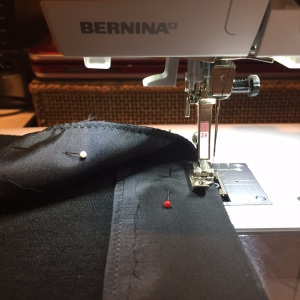
I was so proud of how I had inserted and edgestitched the two famous McCardell pockets in the dress (because McCardell wanted to free women from relying on evening bags), then discovered that I had put one in upside down! The dress was so big at this point, it was hard to keep track of what was the top and what was the bottom.
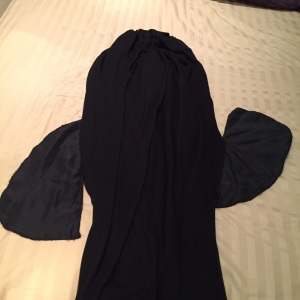
After a quick hack, Frankenpocket was born!
Then I cut another strip of fabric for the neckline, which was to function as both neck binding and cloth ties.
I used this little thingy to turn the ties right-side out. You put a big tube in the casing and use a smaller tube to push it through.
At this point, I tried on the dress, and in the silhouette, I saw this:
That’s Claire McCardell herself, in a dress known as the “futuristic dress.” One of these dresses is in the Metropolitan Museum’s online collection. The dress I was making had a very similar cut, so I had an “aha” moment about how the futuristic dress was constructed.
Now I really had to crank to get the dress done in time for my sister’s event. I gathered the dress in the front and reinforced the gathering with Hug Snug rayon bias tape.
Then I looked at these instructions. Eeeek!
It would probably work, but I was running out of time. Instead, I used the bulky overlock foot again, and basically made the ties by running an overlock stitch over the piping and then trimming it, so I didn’t have to turn anything right side out.
I used the same foot to attach the ties to the front of the dress, rather than hand sewing. It saved me so much time!
I threw on a blind hem, pressed and defuzzed the whole thing, and then right before I put it in my suitcase to New York, I tried it on one last time.
Why am I giving this to my sister!?!?! (Actually, I would adjust the fit for myself anyway, so let’s just say I’m giving Janet a “wearable muslin” for my dress. Shhhh!)
I put the dress in my bag and headed to New York, where I was attending a memorial service for legendary jazz singer and family friend, Jimmy Scott. While seated in the pews at Abyssinian Baptist Church in Harlem, I handed my sister a bag with the dress in it. Would she like it? I was sweating that one.
We parted ways after the service, and not long after, a picture popped up on my phone with the caption “It’s mine now!”
Score another one for stunt sewing! Looks great on her, doesn’t it?
It was such a great experience to recreate this piece of fashion history. The only other version of this dress I’ve seen is here, in the Metropolitan Museum of Art’s Costume Institute collection. I was so glad I’d found that Spadea pattern, because I learned so much about the construction of this classic McCardell design.
In my next post, I’ll be writing about the event where she wore it, and give a report about the Dance and Fashion Exhibit at the Museum at FIT, as well as (finally) details of the Hollywood Costume exhibit.
Hope your sewing’s going well. I’m cooked!
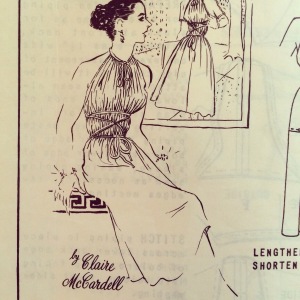
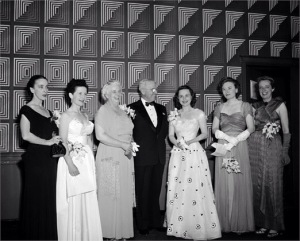
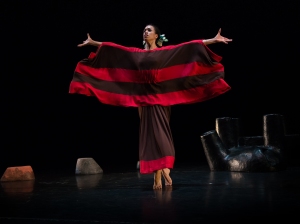
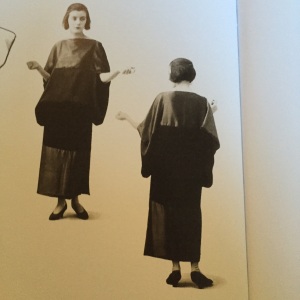

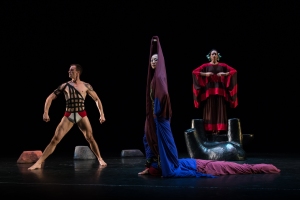
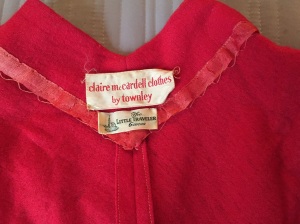
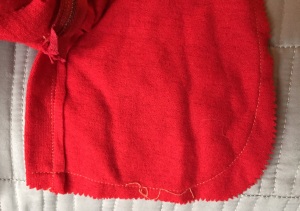
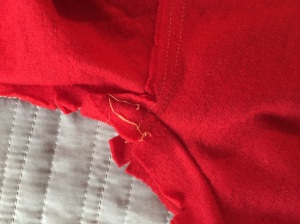
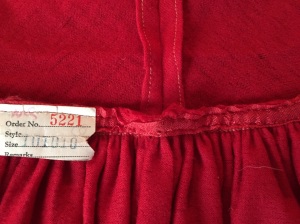



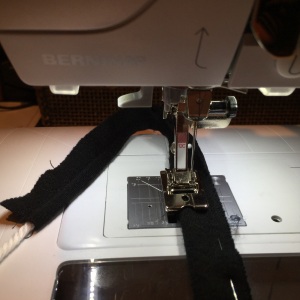

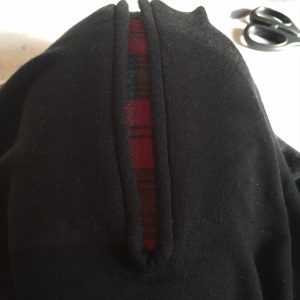
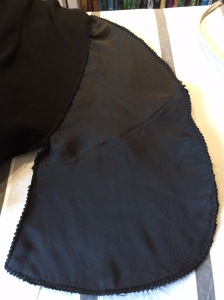
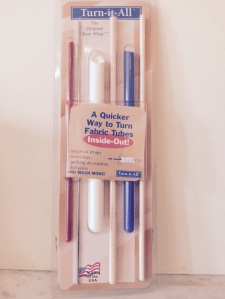
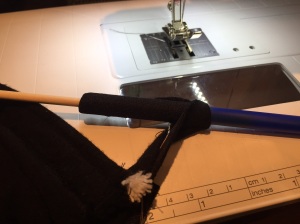
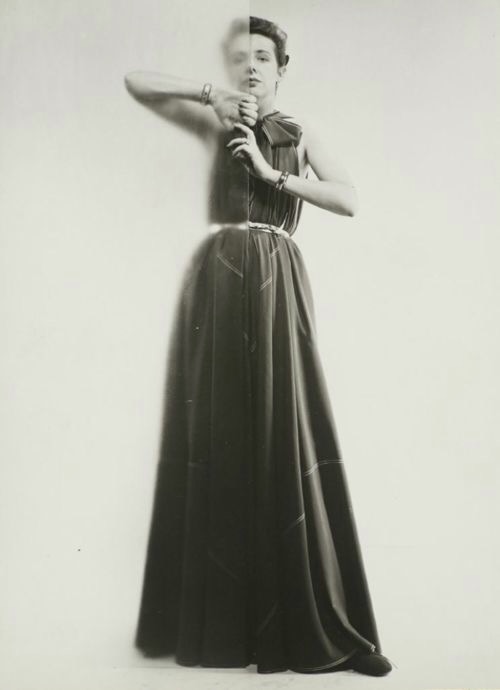
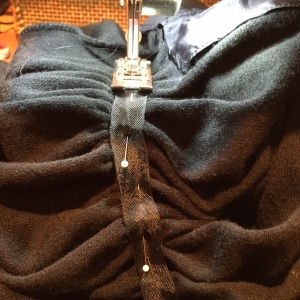
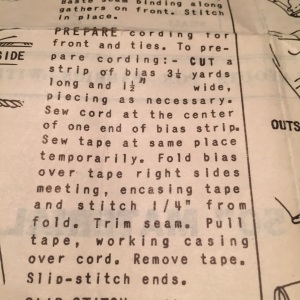
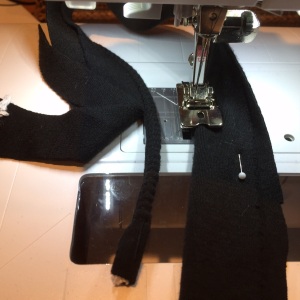
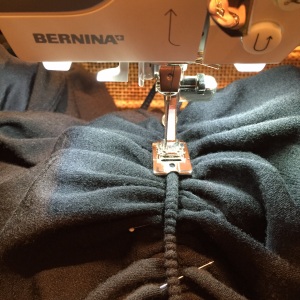


I love MG and how she incorporated fabric itself into dance is still brilliant. CM top 5 of my favorite designers another revolutionary thinker with fabric! What a great combo to blog on. I love the dress and the image in Instagram looks so sliming you can’t really tell how voluminous it really is. You better be careful leaving nice things around sisters, they have a way of dissppearing don’t they. So awesome all of it. As for Threads, Mccardell by a mile!
Thanks Jilly! I think the dress was payback to my sister for a number of items I stole as a teen.
Julie!! You are so awesome!! I am so proud of you!! I love the writing and all of it!! You GO GIRL!! Are you going as one of these women (Claire or Martha?) for Halloween??
Haaaha.. Thank you again for the excellent weekend. Please tell Howell How great great great great it was and Thank YOU TONS!! We were overwhelmed with how wonderful the whole experience was and Jimmy too. With lots of love, pam
Hi Pam, I just found this comment in my spam filter. You win the prize for best cheerleader! It was great to see all of you Vineyarders in NYC. As for Halloween, I went as the mom who steals candy from her unsuspecting child.
Damn, that is a beautiful dress! And what a well written article (post seems so brief); score on the Graham/McCardell photo! As the sewist sister of a semiretired dance historian, you have done well! Hey, I learned something new today!
So kind of your sister to take that muslin off your hands….
Thanks, s.j., that means a lot. (Especially the brief part…I thought it went on and on.) Don’t you love that photo? McCardell and Graham were so far ahead of the curve!
It is great dress .. I would keep it as well. I love your blog! I am looking forward for more!
Thanks Beata! How are your “makes” coming? Any more Chanel jackets in your future?
In the matter of fact – yes… I have just bought great fabric 🙂 First though a dress or a skirt or a coat… too many choinces … as usually – nothin new.
What a fascinating post! I had no idea McCardell and MG had so similar an aesthetic. My DD1 is a dedicated dancer, so this was doubly interesting for me to read. I love your version of this dress. Gorgeous. You’re doing a version for yourself next, right? 😉
Thanks so much! This dress definitely has a “modern dance” costume feel when it’s on. It’s very swishy and swirly. You know, you could do a hack of a Claire McCardell “hostess dress” for DD using a peasant dress pattern with lots of gathering and long strings attached under the bodice. Here’s an example: http://www.metmuseum.org/collection/the-collection-online/search/97499
Wow! Karl can do so many things! It’s a wonderful dress, worn beautifully. Can’ wait to see yours!
Hi Carmen, I know, Karl the Bernina is so talented! Did you know he is also Master of the Stratocaster? I can hear him practicing after we’ve all gone to bed.
Readers, in case you were wondering why I haven’t posted in awhile, it’s because I was watching Carmen sewing her little heart out in the French sewing bee “Cousu Main.” Leggings! Evening wear! A man’s suit jacket in 7 HOURS! I was biting my fingernails instead of blogging!
Carmen, YOU WON!!!! WOO HOO!!! You did an awesome job sewing under all of that pressure. Congratulations!
Great post and fabulous dress. Your sister is so lucky! The fabric suits the design perfectly. I’ve got to get going on my stash of merino wool and you provided some great tips for working with it. Nice to know the LA store will now ship. Your entry in the Threads contest got my vote. Hope you win.
Thanks so much, Mary! That wool jersey is fantastic. It sews so easily and is wonderfully comfortable to wear. I could see it as a top, a drapey cardigan, dress, skirt… In the next post I’ll talk about designer DooRi Chung’s comments during the event at FIT. (She was one of the speakers.) She was talking about how designing with jersey is tricky because it needs volume to not be too clingy. This dress certainly bears that out, as it has tons of volume but doesn’t look bulky.
Wow, a blow by blow account of your amazing sewing skills and ingenuity. Gorgeous dress!
Thanks Lynn! That jersey, Karl and I spent a lot of quality time together.
Does your sister know how lucky she is?? She looks fabulous in that dress, and you need one, too. Loved seeing inside your CMcC dress – thanks for the peek!
Well, I’m lucky to have her as a sister, and the real lucky ones are her two 20-something daughters who will probably be taking possession of the dress. One size fits most!
AMAZING! I love it. I do hope you make another for yourself.
Thank you! I definitely will. For my body type, I will probably go with something flowing like rayon challis, and make a beach dress. The original pattern was drafted for a woven and the dress in the Met Museum is rayon crepe.
Fabulous!!! And thank you so much for the history as well as the dress! it’s stunning – and has pockets – I love her already 😉
Thanks! The pockets are so important to McCardell’s designs. She thought of designing as “solving problems,” and one problem being that a modern woman needed a place to stash a few things. Hence nice deep pockets!
Good morning. I have been a lurking reader of your blog for some time and I want to say I enjoy the way you mix a scholarly knowledge of fashion with style, humour and great workmanship. The end results are modern and don’t look like costumes. So thank you for this.
Welcome Nathalie! I know I have visitors who just stop by to read the posts, and I’m always pleased to “meet” people in the comments. Thank you for your kind words. I’m glad you’re enjoying the blog; I’m having fun, too!
Wow, what an amazing dress. Could tempt me to return to knit-sewing, in fact.
And thank you very much for all the information about these two great women!
Thanks Ette! I like to use vintage techniques when I can, but I have to admit that some of the stitches on these new machines really make life easier. I learned to sew knits on a straight-stitch machine though, and I really think it’s not that hard. Especially using this gorgeous wool; it’s so much easier than a slippery synthetic.
I really love your solution to the pocket mistake. Ingenious! The dress looks fantastic – on both of you.
Hi Lizzie, I think that’s the great thing about sewing on a deadline. You need to make fast decisions without a lot of time to agonize. That said, I’m taking a little break from deadlines and going back to my normal snail’s pace!
Thank you so much for this post. I can’t remember how I discovered you, but I have been reading your blog for some time now. I love how you educate as well as illustrate (and connecting Martha Graham with Claire McCardell is the best). Your posts are so much more interesting than the latest “here is my new quilting cotton blouse with a Peter Pan collar; look, it has darts” posts I see on far too many other blogs.
Thanks so much for stopping by and commenting. I do have fun coming up with these posts, as I’m really a writer at heart, and I did it professionally for years. I’m so glad I’ve found a way to combine my love of writing, sewing, and vintage fashion!
Wow, I’m just in awe after reading this post! What amazing work and skill on display here, and the finished dress is gorgeous.
Thanks very much! I’m getting a kick out of your blog, too. I hope my readers “of a certain age” will check it out: http://unefemme.net/
I do love your content-heavy posts, Julie: historical context, construction details, great photos, performing arts, mythology . . . so much fun to read. And the dress is remarkable.
Thanks Patricia! I’ll use “content-heavy” as my excuse for a few weeks’ lack of posting. It’s lots of fun throwing these posts together in the end, though.
Pingback: Hollywood Costume Exhibit Report (Finally…) | Jet Set Sewing
wow. what a great story, and in-dpeth information about making the dress, Martha Graham, Claire McCardell, and seeing you and your sister in the dress. I totally enjoyed this one.
Glad to hear it, Meg!
The dress turned out great! I love Claire McCardell, have one pattern and hope to get to it soon.
Thanks very much! My sister is getting a lot of wear out of it; now I need to make my own. What McCardell pattern do you have?
This is such an interesting post. I have been trying to create something like this myself, so I really appreciate your detailed advice. Thank you.
may I ask how many yards of fabric you used to make the dress? McCardells always look like they take deceptively small yardage amounts but in the images it looks quite large….
It’s been awhile, but I’d say it took 3 1/2 to 4 yards, and the jersey was wide. It’s very tightly gathered at the neck. The volume of the gathers makes it very swishy to wear!
also.. the lasell college fashion collection has a version of that dress from the early 1950s in ‘stonecutter’ polyester fabric… [in bicolor beige/yellow]
That’s great to know; I’ve seen photos of that version online. It came with a small bolero that I wrote about making in this post: https://jetsetsewing.com/2015/07/03/a-claire-mccardell-bolero-ufo-has-landed-just-in-time-for-international-ufo-day/
That was during the period that McCardell was experimenting with color, and what an unusual combination that was!
Omg, this story has everything: McCardell, Martha Graham, Jimmy Scott (rest his beautiful soul–still in heavy rotation chez nous)…now to figure out if I can do this with 4 yards of delish cotton-linen I just snagged at Mood.
Been hunting down Spadea patterns, to no avail. Is anyone making these available by, dare I say it, copying them? Between this and the Futuristic dress, I’m hoping I can pull it off.
Brava!
Oh hey, welcome to the McCardell cult! There is a copy of a McCardell pattern being sold by Eva Dress that will make a fun 50s version of one of her designs. I’m working on a book about McCardell, and the plan is to include sewing patterns, so at some point I can make more available. Stay tuned!
Hi! I’ve been on the hunt for Claire Mccardell patterns…so hard to find! Are there any photo copies you could possibly share?
I love sewing…but struggle to create patterns, not my forte.
Thanks!
Hi, thanks for stopping by! I’m working on a book about McCardell, and plan to add patterns to it. It will be awhile before it’s available.
Also a big fan of Claire McCardell. I came to New York in 1996 to go to FIT and would spend as much time as permitted in the archive studying her pieces, and taking notes which I’ve lost. I’m finally ready to sew the Monastic, so look forward to seeing your book. (since I have had no luck finding the Spadea pattern). Any updates? nudge nudge. need help? 😉 I’m in NYC.
Thanks very much! I had to stop working on the book for a while for personal reasons, but I’m getting back on it now.